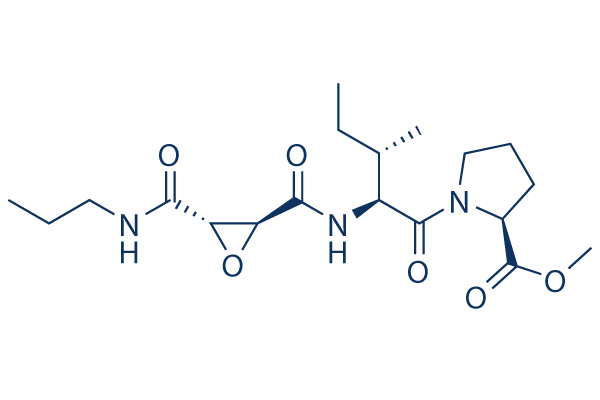
In vitro: CA-074Me is able to inhibit cathepsin L within living HL-60 cells and bloodstream forms of Trypanosoma brucei brucei, but does not inhibit cathepsin L in the absence of thiols. CA-074Me is converted into CA-074 by intracellular esterasesand is, therefore, able to inhibit cathepsin B in GSH-depleted HL-60 cell. It is suggested that CA-074 rather than CA-074Me should be used to selectively inhibit cathespsin B within living cells. Myotube size and number and induced levels of fusion-related creatine phosphokinase activity and myosin heavy-chain protein are reduced from 30 to 50% in CA074Me-treated myoblasts. These reductions are also dose related. Micromolar concentrations of CA074Me inhibit catB activity in differentiating myoblasts.
In vivo: Administration of CA074Me to the London APP mice results in significant improvement in memory deficit, reduces amyloid plaque load in brain, reduces levels of Aβ40 and Aβ42 in brain, and reduces C-terminal β-secretase fragment (CTFβ) derived from APP by β-secretase when compared with untreated control animals. It has no effect on any of these parameters in mice expressing the Swe mutant β-secretase site of APP (in Swedish/London APP mice). In vivo icv administration of CA074Me to normal guinea pigs results in substantial reduction of brain Aβ levels and inhibits β-secretase activity.
| Cell Experiment | |
|---|---|
| Cell lines | HL-60 cells |
| Preparation method | HL-60 cells are pre-treated for 24 h with 200 μM BSO followed by 60 min with 1 mM DEM. Thereafter, the cells(1×106/ml) are incubated with 100 μM CA-074 or CA-074Me, in the presence of 1% DMSO, 200 μM BSO and 1 mM DEM at 37°C. Control cultures are treated with 1% DMSO alone or with 100 μM Z-FA-DMK in the presence of 200 μM BSO and 1 mM DEM. Untreated HL-60 cells are incubated with 100 μM CA-074 or CA-074Me, in the presence of 1% DMSO at 37°C. Untreated control cultures are incubated with 1% DMSO alone or with 100 μM Z-FA-DMK. After 2 h incubation, cells are washed three times with PBS/1% glucose and lysed in 100 mM citrate, pH 5.0, 2% Chaps (106 cells/100 μl). Subsequently, the lysate is centrifuged and the clarified supernatant used to assay for proteolytic activity. |
| Concentrations | 100 μM |
| Incubation time | 2 h |
| Animal Experiment | |
|---|---|
| Animal models | London APP mice |
| Formulation | Saline |
| Dosages | 1 mg/ml |
| Administration | icv |
| Molecular Weight | 397.47 |
| Formula | C19H31N3O6 |
| CAS Number | 147859-80-1 |
| Solubility (25°C) | 79 mg/mL in DMSO |
| Storage |
Powder -20°C 3 years ; 4°C 2 years In solvent -80°C 6 months ; -20°C 1 month |
| Species | Mouse | Rat | Rabbit | Guinea pig | Hamster | Dog |
| Weight (kg) | 0.02 | 0.15 | 1.8 | 0.4 | 0.08 | 10 |
| Body Surface Area (m2) | 0.007 | 0.025 | 0.15 | 0.05 | 0.02 | 0.5 |
| Km factor | 3 | 6 | 12 | 8 | 5 | 20 |
| Animal A (mg/kg) = Animal B (mg/kg) multiplied by | Animal B Km |
| Animal A Km |
For example, to modify the dose of Compound A used for a mouse (20 mg/kg) to a dose based on the BSA for a rat, multiply 20 mg/kg by the Km factor for a mouse and then divide by the Km factor for a rat. This calculation results in a rat equivalent dose for Compound A of 10 mg/kg.
| Related Cathepsin Products |
|---|
| Z-Gly-Pro-Arg-AMC hydrochloride
Z-Gly-Pro-Arg-AMC hydrochloride a fluorescent trypsin and cathepsin K substrate. |
| N-CBZ-Phe-Arg-AMC
N-CBZ-Phe-Arg-AMC (Z-FR-AMC) is a cathepsin substrate used in assessment activity of lysosomal cathepsin enzymes. |
| Ac-Glu-Asp(EDANS)-Lys-Pro-Ile-Leu-Phe-Phe-Arg-Leu-Gly-Lys(DABCYL)-Glu-NH2
Ac-Glu-Asp(EDANS)-Lys-Pro-Ile-Leu-Phe-Phe-Arg-Leu-Gly-Lys(DABCYL)-Glu-NH2 is a cathepsin D substrate, that can be used for cathepsin D FRET assay. |
| (S, S)-Z-FA-FMK
(S,S)-Z-FA-FMK is a cell-permeable, irreversible cathepsin B inhibitor. |
| H-Pro-Thr-Glu-Phe-p-nitro-Phe-Arg-Leu-OH
H-Pro-Thr-Glu-Phe-p-nitro-Phe-Arg-Leu-OH is a water-soluble polypeptide that can serve as a substrate for cathepsin D, pepsin and pepsinogen. |


Products are for research use only. Not for human use. We do not sell to patients.
© Copyright 2010-2023 AbMole BioScience. All Rights Reserved.
